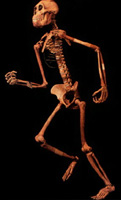The Physical Characteristics of Humans
- Page 6 -
Human Skin as a Heat Diffusion Device
 About four or five million years ago, the evolution of erect walking or bipedalism enabled the ancestors of humans to survive and expand their range during a period of gradually drying climate in Africa that replaced forest with bush and open grasslands. Our ancestral populations had to find ways of ranging about in the new conditions, moving between diminishing stands of forest and sources of water, and learning to forage and survive in more open country. But how efficient was this way of moving?
About four or five million years ago, the evolution of erect walking or bipedalism enabled the ancestors of humans to survive and expand their range during a period of gradually drying climate in Africa that replaced forest with bush and open grasslands. Our ancestral populations had to find ways of ranging about in the new conditions, moving between diminishing stands of forest and sources of water, and learning to forage and survive in more open country. But how efficient was this way of moving?
It depends on how you look at it. Erect walking is not very efficient biologically, in terms of calories expended—at least compared to running on all fours. We cannot match the biological efficiency of wolves or cheetahs in covering ground. Erect walking is, however, quite efficient compared to "knuckle walking"—the form of locomotion natural to apes and from which erect walking probably evolved. But erect walking generates a great deal of chemical heat in the body from the muscular exertion. (See the section on "heat diffusion" below).
Therefore, considered in terms of the overall opportunities that became available to Hominid species with this anatomy, bipedalism must be considered a revolutionary change with enormous advantages. Erect walking opened up new territory to exploit and freed the hands for other tasks, which soon become visible in the fossil record. In this sense, erect walking can be considered highly "efficient" and even partly definitive of our way of life.
Simply in terms of mobility, erect walking created very significant new capabilities that we shouldn’t scoff at. Human beings are not very fast compared to many large mammals, but they are able to run at a speed of about 25 miles per hour for short distances. More often than not, apparently, that was fast enough to get out of harm’s way. Humans can, however, maintain a moderate speed by walking or running for an amazing length of time and can cover long distances. Some Native American groups in historic times hunted deer or caribou by chasing them down, often after a run of 10 km. So, we have only moderate speed but enormous stamina. Apes, in contrast, are simply not capable of such extended exertion. They tire quickly and overheat easily.
 About four or five million years ago, the evolution of erect walking or bipedalism enabled the ancestors of humans to survive and expand their range during a period of gradually drying climate in Africa that replaced forest with bush and open grasslands. Our ancestral populations had to find ways of ranging about in the new conditions, moving between diminishing stands of forest and sources of water, and learning to forage and survive in more open country. But how efficient was this way of moving?
About four or five million years ago, the evolution of erect walking or bipedalism enabled the ancestors of humans to survive and expand their range during a period of gradually drying climate in Africa that replaced forest with bush and open grasslands. Our ancestral populations had to find ways of ranging about in the new conditions, moving between diminishing stands of forest and sources of water, and learning to forage and survive in more open country. But how efficient was this way of moving? 
